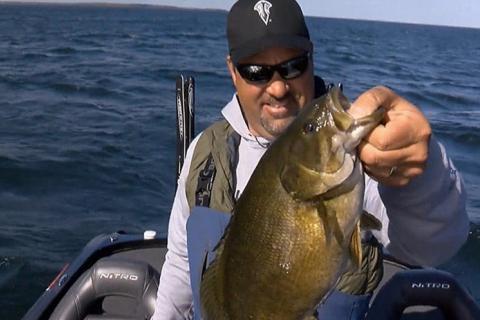
Mark Zona, host of Zona’s Awesome Fishing Show, grew up fishing the cold-water months in Michigan always believing that a blade bait was the best weapon in 35- to 45-degree water.
He’s been proven wrong. Using a swimbait, he’s tapped into 100-fish schools bunched up in cold water looking to feed.

The Fishing Bait is Key
On the inland lakes in Michigan that he targets, nothing beats a Strike King 3.75 Rage Tail Swimmer, Zona says.
He’ll doctor the bait by cutting off a ¼-inch and using a pair of scissors, he’ll trim the front of the bait to help the tail wag more.
 “It has a very subtle action yet it mimics what bass are hunting better than anything,” he said. What they’re hunting could range from bluegill to perch to emerald shiners which he’ll target using the Mega Imaging feature with his Humminbird Helix Gen 2 technology fishfinder units.
“It has a very subtle action yet it mimics what bass are hunting better than anything,” he said. What they’re hunting could range from bluegill to perch to emerald shiners which he’ll target using the Mega Imaging feature with his Humminbird Helix Gen 2 technology fishfinder units.
Matching the Fishing Technique to the Conditions
What depth zone the bass are holding in is critical to deciding the jig head weight.
Water 20-feet or less calls for a home-poured 3/8-ounce jig with a 2/0 hook while anything deeper means he’ll opt for a 5/16-ounce jig.
Finding newly emergent sand grass, deep milfoil, or coon tail growing n o more than a couple inches from the bottom with a little bit of wood interspersed. Finding rocks mixed in are a bonus.
o more than a couple inches from the bottom with a little bit of wood interspersed. Finding rocks mixed in are a bonus.
Zona says there’s only one way to work the bait. He’ll make a super long cast, in 15- to 40-feet of water, until it hangs up in the grass. Then, he’ll bounce the slack in the line as the swimbait is hung in the grass until a largemouth rips it free. Don’t believe it works? When fish start coming to the boat, they’ll often have grass in their gullet.
Generally, Zona prefers deep-water flats. He’s not a fan of vertical structure with a sheer drop as he’s found that bass tend to suspend.
Using both 2d and Down Imaging with his Humminbird Helix units with Mega Imaging, he’ll look for the perfect structure.
“I like a table top where they have to swim a long to get shallow. It’s featureless as far as depth but that’s why a small piece of structure makes it so special because it’s a desert. A twig or a patch of grass, become a palm tree,” Zona said.
There has to be a reason that they have stayed there all winter long Zona explains.
When it gets above 45-degrees the massive schools of fish break up. He’ll opt for a different retrieve by slow reeling just above the bottom.
Gearing Up for Super Long Casts

To achieve the super long casts to make this technique work, he’ll spool 15-pound Seaguar Smackdown braided fishing line on a Daiwa Tatula LT 3000 reel.
The larger spool facilitates those longer casts and picks up a lot of line on the retrieve.
What is especially important is running a 15-foot leader of Seaguar Tatsu fluorocarbon.
He ties on the longer leader to keep the action of the bait dull and not reactionary to the braid. Due to the no-stretch properties of braided line, he found that a shorter leader ripped the jig out of the grass preventing it from being worked out of the grass as needed for the technique to entice bites.
Zona cautions anglers that 99% of the bites aren’t felt so the added sensitivity of the braided line is key as is using the proper rod for the job. Most times, bass will track the Rage Swimmer as it comes through the water and once they bite the rod will load up and start to bend leaving the angler no choice but to lean back with the rod to set the hook with a steady pull.
When fishing the 5/16-ounce jig, he’ll opt for the Daiwa Tatula Brent Ehrler Drops Hot rod while the 3/8-ounce jig works better with the Daiwa Tatula Randy Howell Underspin/Shaky Head rod.
In clearer water, look for bass in 20- to 40-feet of water while darker water sees 12- to 20-feet of water come into play. Zona stresses that if they can’t see it, they can’t eat it.
His favorite colors include KVD Magic, Pro Blue Red Glimmer, and Ayu.
- 4820 views

